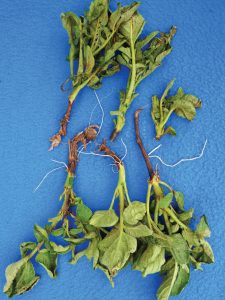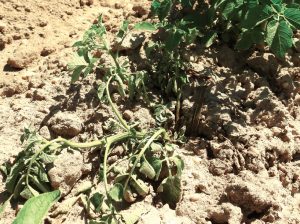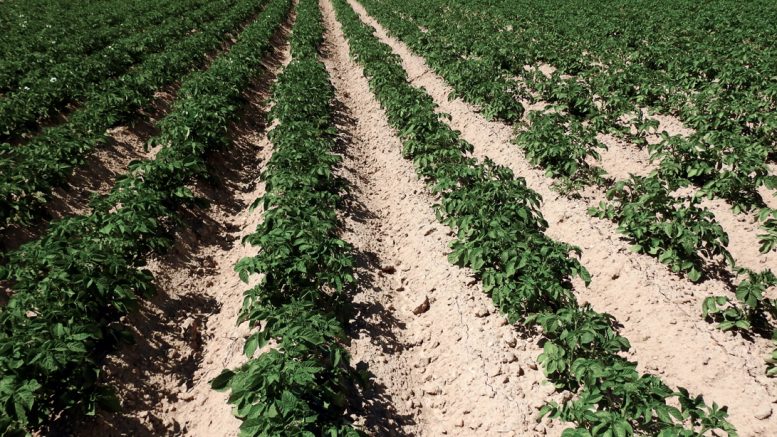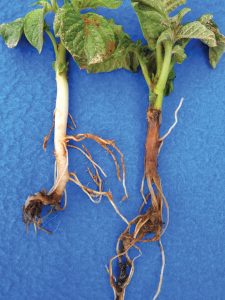By Margaret Tuttle McGrath, Plant Pathology and Plant-Microbe Biology Section, Cornell University
Dickeya (also known as Dickeya blackleg) is a destructive disease all potato growers should be aware of, including those in the western U.S., although most occurrences have been in the eastern U.S. So far, the disease has been confirmed in 22 states: Maine, Massachusetts, Rhode Island, New York, Pennsylvania, New Jersey, Delaware, Maryland, West Virginia, Virginia, North Carolina, Florida, Texas, New Mexico, Missouri, Ohio, Indiana, Michigan, Wisconsin, Minnesota, North Dakota and Idaho.
The pathogen has demonstrated ability to cause total loss of the crop when conditions are very favorable. Knowledge about Dickeya empowers growers to avoid occurrence in their crop. The disease cannot be managed once established in a production field as there are no resistant varieties and no effective bactericides.
This new disease in the U.S. is similar to blackleg, a common disease that has been occurring for years. But based on observations made to date, these diseases are different in important ways that affect management.
Similarities to Blackleg
The two diseases are caused by related bacteria. Dickeya dianthicola causes Dickeya, and Pectobacterium atrosepticum causes blackleg and aerial stem rot. Symptoms of both include brown, rotting stem tissue and tuber soft rot. Both bacteria are seed-borne, and both can spread during harvest.
Differences From Blackleg
Dickeya can initiate disease in a crop from lower inoculum levels and is considerably more aggressive than blackleg. Dickeya has higher optimal temperature for disease development. Above 77 degrees Fahrenheit is favorable, with above 85 degrees being ideal.
Pectobacterium can be spread during seed cutting, thereby increasing the number of contaminated seed pieces. Observations on Dickeya occurrence suggest spread is not occurring this way. Characteristics of Pectobacterium enable it to stick on tools after cutting a contaminated tuber.
Dickeya has a greater ability to spread through the plant’s vascular tissue. Stem symptoms caused by Dickeya start at the seed piece and move up the stem. Stems rot from the inside out. Symptoms of blackleg also start at the seed piece. In contrast, symptoms of aerial stem rot start on stem tissue above ground, often associated with wounds, and progress down the stem as well as upward, and from the stem outside progressing inward. Occasionally, especially late in the season, only internal stem tissue will be discolored on Dickeya-affected plants.
An unthrifty appearance is another symptom of Dickeya. This is thought to be the result of conditions being unfavorable for bacteria to multiple to the number needed to result in symptoms.

Symptoms of Dickeya on stems progress upward and outward from inside stems. Affected tissue is dark brown to black, and not slimy as with blackleg.
Stem tissue affected by blackleg typically has an offensive odor and is slimy. In contrast, plant tissue affected by Dickeya typically has an earthy smell; occasionally it has an offensive smell, indicating soft rot bacteria are also present.
Pectobacterium (aerial stem rot) is dispersed by splashing water within a planting. Apparently lacking aerial stem symptoms, Dickeya is not thought to be able to be moved this way, but it might move in water moving across the soil surface following an intensive rainstorm.
Applying copper fungicides/bactericides may suppress aerial stem rot. If Dickeya is not dispersed aerially, as suspected, then these products will not have an impact on disease development.
Pectobacterium can survive between crops in soil (not associated with a potato tuber) for at least a year. In a controlled study, survival in soil was only seven days for Dickeya while it was 942 days for Pectobacterium. Additionally, Pectobacterium has been detected in field soil near affected plants, while Dickeya so far has not. Pectobacterium can survive in irrigation ponds, albeit not for long. Dickeya has been detected in water, but the species is not D. dianthicola; it might be D. aquaticus.
Alternative host plants are considered to be important in the life cycle of Pectobacterium, but not of Dickeya because this bacterium does not appear to be able to survive in plant debris.
Appropriate potato storage conditions are too cool for Dickeya to be active, but not too cool for Pectobacterium to continue to develop. While both pathogens can be spread from diseased to healthy tubers during harvest, with Dickeya this is only important with seed potatoes because symptoms are not expected to develop under cool storage conditions.
It is important to note that many of these potential conclusions about Dickeya are negatives. For example, it does not spread during seed cutting, does not survive in soil or water, alternative host plants are not important, etc. It is not possible to prove a negative, only a positive. And there is no defined amount of research to conduct to reach such negative conclusions.
Management Steps
Pathogen-free seed is the only known effective management practice, so select certified seed with negligible potential to be contaminated. For information on steps to take, see the management recommendations file at www.vegetablemdonline.ppath.cornell.edu/NewsArticles/Potato-Dickeya.html. Note that infected seed often is symptomless.
Dickeya is not a regulated pathogen, at least partly reflecting the fact when first identified it was found present in many states. A national tolerance level has not been established yet in the U.S. Scotland has a zero tolerance policy. Dickeya solani is a more aggressive, regulated pathogen that has not been detected in the U.S. yet.
Other management steps include disinfesting all equipment during seed piece cutting on a regular basis, and rotating land. These practices probably are not important for Dickeya, but this has not been confirmed, and they are important for blackleg.
In addition, inspect fields for symptoms regularly. The first symptom is poor emergence (skips in a production field) due to rotting seed. Plants that emerge from contaminated seed develop symptoms of wilt and black stems typically following a period of hot weather especially when plants are also stressed. Report suspect occurrence. Symptoms may not develop in the absence of hot weather during the growing season.
It is also important to avoid excess irrigation.

Infected plants often collapse following a period of hot weather especially when they are also stressed. Lower stem tissue of this plant has dark brown-black discoloration characteristic of Dickeya.
Detection Methods
Dickeya has been difficult to detect in tubers with molecular techniques (PCR tests) because this type of tissue can interfere with the test. It is more easily detected in stem tissue. Dickeya has developed in fields planted with seed that tested negative. Testing methods are better now. There are two PCR tests being used: PelADE for Dickeya and Dia-C for Dickeya dianthicola.
Originally published in Potato Country May/June



